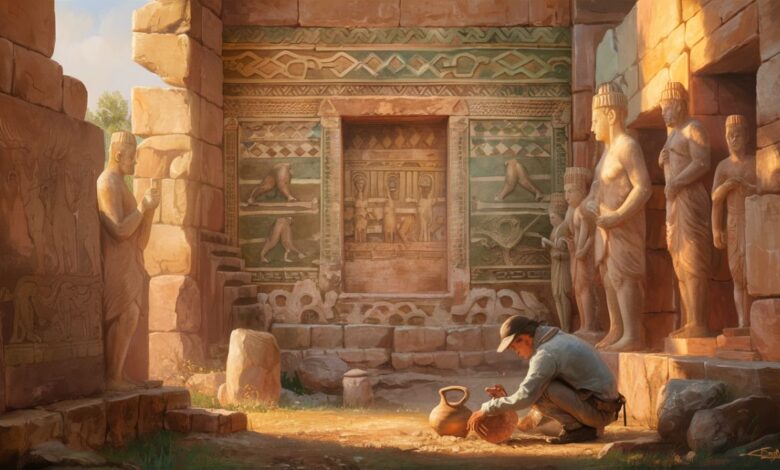Title: Ancient Artz: Unlocking the Mysteries of Our Past

Introduction
Ancient Artz isn’t just a collection of artifacts and remnants; it’s a powerful bridge to civilizations that have shaped the way we live and think today. It spans millennia, encompassing cultures that left their mark on humanity with unique styles, symbols, and artistic techniques. This art not only served aesthetic purposes but also carried religious, social, and political significance. From the monumental pyramids of Egypt to the delicate pottery of ancient Greece, each piece tells a story about the people who created it. So, let’s dive into the mesmerizing world of Ancient Artz and see how these ancient masterpieces continue to inspire and inform us today.
Culture
Every ancient civilization expressed its unique worldview through art, capturing their distinct cultures for future generations. The art of ancient Egypt, for instance, was deeply tied to their religious beliefs. Gods, goddesses, and myths were immortalized in statues and paintings. Similarly, Mesopotamian art was often crafted to celebrate rulers and warriors, highlighting a culture deeply embedded in hierarchy and power. By studying these works, we can trace cultural trends and understand what each society held sacred, feared, or revered.
Symbols
Ancient Artz is rich with symbols that carry deep meanings. For instance, the ankh in Egyptian art symbolized life, while the lotus flower in ancient Indian art represented purity and rebirth. In Mesoamerican art, symbols such as jaguars and eagles denoted power and authority, often linked to gods and rulers. These symbols communicated messages that transcended time and language, helping us today to better understand the values, beliefs, and emotions of ancient societies.
Purpose
Art in ancient times wasn’t merely decorative; it served various purposes, ranging from religious and ceremonial to functional. Egyptian sculptures adorned tombs as part of burial rituals, believed to ensure safe passage into the afterlife. Similarly, Greek pottery often depicted scenes from mythology and daily life, serving as storytelling tools in an era without written records for the masses. This multifunctional nature of ancient art reveals the practical and spiritual priorities of these cultures, highlighting their understanding of art as a medium to connect with the divine and document human experience.
Techniques
The techniques used in Ancient Artz were as diverse as the cultures they represented. Stone carving, for example, was common in Egypt and Mesoamerica, where large structures were created to last eternally. Ancient Greeks mastered the art of marble carving, producing statues with life-like detail and proportion. Chinese artists perfected ink painting techniques, capturing landscapes with simplicity and elegance. Even today, artists and historians study these methods, learning the craftsmanship that allowed such precision and durability without the modern tools we now rely on.
Evolution
The art of ancient civilizations evolved over time, often influenced by contact with other cultures. For example, when Alexander the Great’s empire expanded into Persia, Greece’s classical art style merged with Persian influences, resulting in Hellenistic art. This evolution reflects the interconnectedness of human societies, showing how ideas traveled, blended, and gave birth to new forms. Ancient Artz, therefore, isn’t static; it embodies a constantly shifting legacy shaped by trade, conquest, and cultural exchange.
Influence
Ancient Artz’s influence is profound and enduring, affecting everything from architecture to pop culture. Roman architecture inspired the Renaissance, while Egyptian motifs found their way into Art Deco designs. Artists like Michelangelo and Pablo Picasso were inspired by classical Greek and African art forms, respectively, demonstrating how ancient styles and themes continuously influence artistic expression. Even today, designers, architects, and filmmakers draw from the rich reservoir of ancient art, using it to bring depth and historical resonance to their work.
Legacy
The legacy of Ancient Artz isn’t confined to museums or history books. Its themes of life, death, power, and faith are universal, resonating with people across generations and cultures. This legacy connects us to our ancestors, reminding us of shared human experiences, no matter how much our world has changed. For artists, historians, and everyday viewers, ancient art offers a wellspring of inspiration and understanding—a reminder of what has always mattered to human beings throughout the ages.
Conclusion
Ancient Artz is more than just art; it’s a living connection to the minds, beliefs, and experiences of civilizations that came before us. These masterpieces are not only visually stunning but also rich with meaning, holding stories that still resonate today. By studying Ancient Artz, we get a glimpse into the diverse worlds of our ancestors, discovering what they valued, how they expressed themselves, and how they understood the world.





